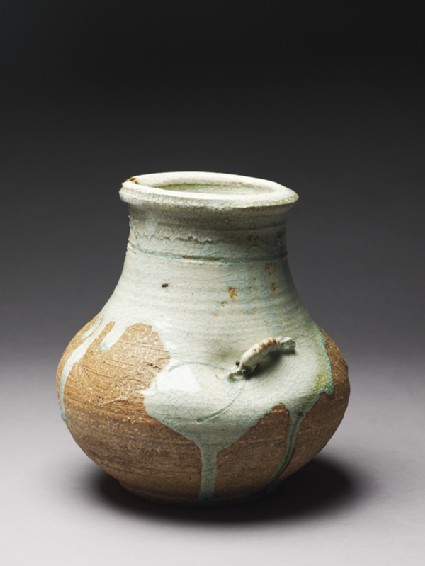Miyagawa (Makuzu) Kōzan (1842-1916)
Discover our beautiful collection of works by one of Japan's most influential artists.

Collection trails: 1 object
- Reference URL
Actions
Globular vase with a shrimp
-
Details
- Associated place
- Date
- 1925 - 1940
- Artist/maker
-
Miyagawa Hanzan (1859 - 1940) (potter)
- Material and technique
- stoneware, thrown, with engraved and modelled decoration, partly covered with a green celadon glaze
- Dimensions
-
26 cm (height)
24 cm (diameter)
- Material index
- Technique index
- Object type index
- No. of items
- 1
- Credit line
- Purchased with the assistance of the Story Fund, 1990.
- Accession no.
- EA1990.1
-
Further reading
Impey, Oliver, and Joyce Seaman, Japanese Decorative Arts of the Meiji Period 1868-1912, Ashmolean Handbooks (Oxford: Ashmolean Museum, 2005), no. 11 on p. 26, p. 8, illus. pp. 26-27
Pollard, Clare, Master potter of Meiji Japan: Makuzu Kōzan (1842-1916) and his Workshop, Oxford Oriental monographs (Oxford: Oxford University Press, 2002), p. 112, pl. 39
Impey, Oliver, ‘Reflections upon the Arts and Crafts of Meiji Period Japan with Reference to the Collection of the Ashmolean Museum’, Oriental Art, 42/3, (Autumn 1996), p. 12, illus. p. 14 fig. 9
Glossary (2)
glaze, stoneware
-
glaze
Vitreous coating applied to the surface of a ceramic to make it impermeable or for decorative effect.
-
stoneware
Ceramic material made of clay which is fired to a temperature of c.1200-1300⁰c and is often buff or grey in colour.
Location
Objects are sometimes moved to a different location. Our object location data is usually updated on a monthly basis. Contact the Jameel Study Centre if you are planning to visit the museum to see a particular object on display, or would like to arrange an appointment to see an object in our reserve collections.
Collection trails
Galleries
Publications online
-

Japanese Decorative Arts of the Meiji Period
Globular stoneware vase partially glazed in pale green, leaving much of the rough body unglazed, with engraved decoration on the neck and body, with a prawn modelled in high relief on the body. Impressed seal on the base: Makuza in a double gourd.
Shortly before Kōzan I's death in 1916, the factory began to make stoneware vessels in the manner of the Iga kilns, admittedly somewhat remotely, even using the local Shigaraki clay and glazes; most of these are based on old Japanese shapes, usually related to the tea ceremony - this might have been a mizusashi, though the box does not say so.
The original box (lost before the pot reached the museum), was inscribed with the character for Iga (Christie's, London, 7 March, 1989, lot 453).
© 2013 University of Oxford - Ashmolean Museum












